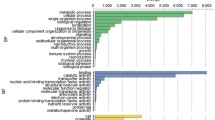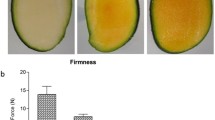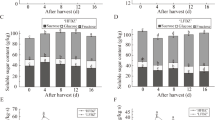Abstract
Mango is flavour-rich fruit and considered as king of fruit in India. About 578 volatile compounds have so far been identified in various cultivars. These are believed to accumulate differentially during the course of ripening. In order to understand the molecular mechanism of aroma in mango, de novo transcriptome assembly and analysis of Mangifera indica (Dashehari) were performed by Illumina sequencing. Mining of transcriptome data led to identification of major genes related to most of the genes of terpenoid, carotenoid, flavonoid, lactone, lipoxygenase, aromatic amino acid, alkaloid, and phenylpropanoid pathways, which are potentially involved in aroma biosynthesis. Comparative mRNA expression analysis in five Mango varieties (Dashehari, Banganpalli, Ratna, Mallika, and Alphonso) revealed varietal and ripening-related differences. To gain further insight into the terpenoid pathway, these genes were further studied in different tissues and developmental stages in Dashehari mango. This study is stepping stone to understand aroma pathways in different varieties of mango fruit.








Similar content being viewed by others
References
Ahumada I, Cairó A, Hemmerlin A, González V, Pateraki I, Bach TJ, Rodríguez-Concepción M, Campos N, Boronat A (2008) Characterisation of the gene family encoding acetoacetyl-CoA thiolase in Arabidopsis. Funct Plant Biol 35(11):1100–1111
Asif MH, Dhawan P, Nath P (2000) A simple procedure for the isolation of high quality RNA from ripening banana fruit. Plant Mol Biol Report 18(2):109–115
Azim MK, Khan IA, Zhang Y (2014) Characterization of mango (Mangifera indica L.) transcriptome and chloroplast genome. Plant Mol Biol 85(1):193–208
Bach TJ, Lichtenthaler HK (1983) Inhibition by mevinolin of plant growth, sterol formation and pigment accumulation. Physiol Plant 59(1):50–60
Berardini N, Fezer R, Conrad J, Beifuss U, Carle R, Schieber A (2005) Screening of mango (Mangifera indica L.) cultivars for their contents of flavonol O-and xanthone C-glycosides, anthocyanins, and pectin. J Agric Food Chem 53(5):1563–1570
Bhambhani S, Lakhwani D, Gupta P, Pandey A, Dhar YV, Bag SK, Asif MH, Trivedi PK (2017) Transcriptome and metabolite analyses in Azadirachta indica: identification of genes involved in biosynthesis of bioactive triterpenoids. Sci Rep 7(1):5043
Bojorquez G, Gómez-Lim MA (1995) Peroxisomal thiolase mRNA is induced during mango fruit ripening. Plant Mol Biol 28(5):811–820
Boss PK, Davies C, Robinson SP (1996) Analysis of the expression of anthocyanin pathway genes in developing Vitis vinifera L. cv Shiraz grape berries and the implications for pathway regulation. Plant Physiol 111(4):1059–1066
Cane DE (1999) Sesquiterpene biosynthesis: Cyclization mechanisms. In: Cane DD (ed) Comprehensive natural products chemistry, isoprenoids including carotenoids and steroids, vol 2
Carrie C, Murcha MW, Millar AH, Smith SM, Whelan J (2007) Nine 3-ketoacyl-CoA thiolases (KATs) and acetoacetyl-CoA thiolases (ACATs) encoded by five genes in Arabidopsis thaliana are targeted either to peroxisomes or cytosol but not to mitochondria. Plant Mol Biol 63(1):97–108
Chen Q, Yan J, Meng X, Xu F, Zhang W, Liao Y, Qu J (2017) Molecular cloning, characterization, and functional analysis of acetyl-CoA C-acetyltransferase and mevalonate kinase genes involved in terpene trilactone biosynthesis from Ginkgo biloba. Molecules 22(1):74
Chourasia A, Sane VA, Nath P (2006) Differential expression of pectate lyase during ethylene‐induced postharvest softening of mango (Mangifera indica var. Dashehari). Physiologia Plantarum 128(3):546–555
Chourasia A, Sane VA, Singh RK, Nath P (2008) Isolation and characterization of the MiCel1 gene from mango: ripening related expression and enhanced endoglucanase activity during softening. Plant Growth Regul 56(2):117
Dautt-Castro M, Ochoa-Leyva A, Contreras-Vergara CA, Pacheco-Sanchez MA, Casas-Flores S, Sanchez-Flores A, Kuhn DN, Islas-Osuna MA (2015) Mango (Mangifera indica L.) cv. Kent fruit mesocarp de novo transcriptome assembly identifies gene families important for ripening. Front Plant Sci 6:62
Deshpande AB, Anamika K, Jha V, Chidley HG, Oak PS, Kadoo NY, Pujari KH, Giri AP, Gupta VS (2017) Transcriptional transitions in Alphonso mango (Mangifera indica L.) during fruit development and ripening explain its distinct aroma and shelf life characteristics. Scientific Rep 7(1):8711
Dudareva N, Pichersky E, Gershenzon J (2004) Biochemistry of plant volatiles. Plant Physiol 135(4):1893–1902
Dyer JH, Maina A, Gomez ID, Cadet M, Oeljeklaus S, Schiedel AC (2009) Cloning, expression and purification of an acetoacetyl CoA thiolase from sunflower cotyledon. Int J Biol Sci 5(7):736
Estévez JM, Cantero A, Reindl A, Reichler S, León P (2001) 1-Deoxy-d-xylulose-5-phosphate synthase, a limiting enzyme for plastidic isoprenoid biosynthesis in plants. J Biol Chem 276(25):22901–22909
Gaffe J, Bru JP, Causse M, Vidal A, Stamitti-Bert L, Carde JP, Gallusci P (2000) LEFPS1, a tomato farnesyl pyrophosphate gene highly expressed during early fruit development. Plant Physiol 123(4):1351–1362
Gallón SMN, Elejalde-Palmett C, Daudu D, Liesecke F, Jullien F, Papon N, De Bernonville TD, Courdavault V, Lanoue A, Oudin A, Glévarec G (2017) Virus-induced gene silencing of the two squalene synthase isoforms of apple tree (Malus× domestica L.) negatively impacts phytosterol biosynthesis, plastid pigmentation and leaf growth. Planta 246(1):45–60
Grassi S, Piro G, Lee JM, Zheng Y, Fei Z, Dalessandro G, Giovannoni JJ, Lenucci MS (2013) Comparative genomics reveals candidate carotenoid pathway regulators of ripening watermelon fruit. BMC Genom 14(1):781
Janave MT, Sharma A (2008) Spongy tissue development in Alphonso mango: association with Staphylococcus xylosus. Eur J Plant Pathol 122(3):335–348
Jozefczuk J, Adjaye J (2011) Quantitative real-time PCR-based analysis of gene expression. Methods Enzymol (500):99–109. Academic Press
Karihaloo JL, Dwivedi YK, Archak S, Gaikwad AB (2003) Analysis of genetic diversity of Indian mango cultivars using RAPD markers. J Hortic Sci Biotechnol 78(3):285–289
Keller Y, Bouvier F, d’Harlingue A, Camara B (1998) Metabolic compartmentation of plastid prenyllipid biosynthesis: evidence for the involvement of a multifunctional geranylgeranyl reductase. Eur J Biochem 251(1–2):413–417
Kim JI, Ciesielski PN, Donohoe BS, Chapple C, Li X (2014) Chemically induced conditional rescue of the reduced epidermal fluorescence8 mutant of Arabidopsis reveals rapid restoration of growth and selective turnover of secondary metabolite pools. Plant Physiol 164(2):584–595
Kim SJ, Kim MD, Choi JH, Kim SY, Ryu YW, Seo JH (2006) Amplification of 1-deoxy-d-xyluose 5-phosphate (DXP) synthase level increases coenzyme Q10 production in recombinant Escherichia coli. Appl Microbiol Biotechnol 72(5):982–985
Kollas AK, Duin EC, Eberl M, Altincicek B, Hintz M, Reichenberg A, Henschker D, Henne A, Steinbrecher I, Ostrovsky DN, Hedderich R (2002) Functional characterization of GcpE, an essential enzyme of the non-mevalonate pathway of isoprenoid biosynthesis. FEBS Lett 532(3):432–436
Kulkarni R, Pandit S, Chidley H, Nagel R, Schmidt A, Gershenzon J, Pujari K, Giri A, Gupta V (2013) Characterization of three novel isoprenyl diphosphate synthases from the terpenoid rich mango fruit. Plant Physiol Biochem 71:121–131
Kumar A, Ellis BE (20010 The phenylalanine ammonia-lyase gene family in raspberry. Structure, expression, and evolution. Plant Physiol 127(1):230–239
Kumar H, Narayanaswamy P, Prasad T, Mukunda GK, Sondur S (2001) Estimation of genetic diversity of commercial mango (Mangifera indica L.) cultivars using RAPD markers. J Hortic Sci Biotechnol 76(5):529–533
Kuzuyama T, Takahashi S, Watanabe H, Seto H (1998) Direct formation of 2-C-methyl-D-erythritol 4-phosphate from 1-deoxy-D-xylulose 5-phosphate by 1-deoxy-D-xylulose 5-phosphate reductoisomerase, a new enzyme in the non-mevalonate pathway to isopentenyl diphosphate. Tetrahedron Lett 39(25):4509–4512
Lalel HJ, Singh Z, Tan SC (2003) Aroma volatiles production during fruit ripening of ‘Kensington Pride’ mango. Postharvest Biol Technol 27(3):323–336
Lee MH, Jeong JH, Seo JW, Shin CG, Kim YS, In JG, Yang DC, Yi JS, Choi YE (2004) Enhanced triterpene and phytosterol biosynthesis in Panax ginseng overexpressing squalene synthase gene. Plant Cell Physiol 45(8):976–984
Leng X, Wang P, Wang C, Zhu X, Li X, Li H, Mu Q, Li A, Liu Z, Fang J (2017) Genome-wide identification and characterization of genes involved in carotenoid metabolic in three stages of grapevine fruit development. Sci Rep 7(1):4216
Li H, Wu H, Qi Q, Li H, Li Z, Chen S, Ding Q, Wang Q, Yan Z, Gai Y, Jiang X (2019) Gibberellins play a role in regulating tomato fruit ripening. Plant Cell Physiol 60(7):1619–1629
Li L, Ma XW, Zhan RL, Wu HX, Yao QS, Xu WT, Luo C, Zhou YG, Liang QZ, Wang SB (2017) Profiling of volatile fragrant components in a mini-core collection of mango germplasms from seven countries. PLoS One 12(12):e0187487
Liao P, Wang H, Wang M, Hsiao AS, Bach TJ, Chye ML (2014) Transgenic tobacco overexpressing Brassica juncea HMGCoA synthase 1 shows increased plant growth, pod size and seed yield. PLoS One 9(5):e98264
Liu L, Li Y, She G, Zhang X, Jordan B, Chen Q, Zhao J, Wan X (2018) Metabolite profiling and transcriptomic analyses reveal an essential role of UVR8-mediated signal transduction pathway in regulating flavonoid biosynthesis in tea plants (Camellia sinensis) in response to shading. BMC Plant Biol 18(1):233
Livak KJ, Schmittgen TD (2001) Analysis of relative gene expression data using real-time quantitative PCR and the 2− ΔΔCT method. Methods 25(4):402–408
Lois LM, Rodríguez-Concepción M, Gallego F, Campos N, Boronat A (2000) Carotenoid biosynthesis during tomato fruit development: regulatory role of 1-deoxy-D-xylulose 5-phosphate synthase. Plant J 22(6):503–513
Ma X, Luo X, Wei Y, Bai T, Shi J, Li L, Zhang J, Wu H (2021) Chromosome-scale genome and comparative transcriptomic analysis reveal transcriptional regulators of β-carotene biosynthesis in Mango. Front Plant Sci p 2150
Martinkus C, Croteau R (1981) Metabolism of monoterpenes: evidence for compartmentation of l-menthone metabolism in peppermint (Mentha piperita) leaves. Plant Physiol 68(1):99–106
Nagegowda DA (2010) Plant volatile terpenoid metabolism: biosynthetic genes, transcriptional regulation and subcellular compartmentation. FEBS Lett 584(14):2965–2973
Naik KC, Gangolly SR (1950) A monograph on classification and nomenclature of South Indian mangoes. A monograph on classification and nomenclature of South Indian mangoes.
Oeljeklaus S, Fischer K, Gerhardt B (2002) Glyoxysomal acetoacetyl-CoA thiolase and 3-oxoacyl-CoA thiolase from sunflower cotyledons. Planta 214(4):597–607
Okada K, Hase T (2005) Cyanobacterial non-mevalonate pathway: (E )-4-hydroxy-3-methylbut-2-enyl diphosphate synthase interacts with ferredoxin in Thermosynechococcus elongatus BP-1. J Biol Chem 280:20672–20679
Pal RK (1998) Ripening and rheological properties of mango as influenced by ethrel and calcium carbide. J Food Sci Technol 35(4):358–360
Pandit SS, Chidley HG, Kulkarni RS, Pujari KH, Giri AP, Gupta VS (2009a) Cultivar relationships in mango based on fruit volatile profiles. Food Chem 114(1):363–372
Pandit SS, Kulkarni RS, Chidley HG, Giri AP, Pujari KH, Köllner TG, Degenhardt J, Gershenzon J, Gupta VS (2009b) Changes in volatile composition during fruit development and ripening of ‘Alphonso’ mango. J Sci Food Agric 89(12):2071–2081
Pandit SS, Kulkarni RS, Giri AP, Köllner TG, Degenhardt J, Gershenzon J, Gupta VS (2010) Expression profiling of various genes during the fruit development and ripening of mango. Plant Physiol Biochem 48(6):426–433
Pandit SS, Mitra S, Giri AP, Pujari KH, Patil BP, Jambhale ND, Gupta VS (2007) Genetic diversity analysis of mango cultivars using inter simple sequence repeat markers. Curr Sci pp.1135–1141
Pino JA, Mesa J, Muñoz Y, Martí MP, Marbot R (2005) Volatile components from mango (Mangifera indica L.) cultivars. J Agric Food Chem 53(6):2213–2223
Preethi P, Soorianathasundaram K, Subramanian KS (2014) Aroma volatile compounds of mango cultivars neelum and banganapalli. Biochem Cell Arch 14(2):421–425
Ramirez JE, Zambrano R, Sepulveda B, Simirgiotis MJ (2013) Antioxidant properties and hyphenated HPLC–PDA–MS profiling of Chilean Pica mango fruits (Mangifera indica L. cv. piqueno). Molecules 19:438–458
Ravishankar KV, Anand L, Dinesh MR (2000) Assessment of genetic relatedness among mango cultivars of India using RAPD markers. J Hortic Sci Biotechnol 75(2):198–201
Ribeiro SMR, Barbosa LCA, Queiroz JH, Knödler M, Schieber A (2008) Phenolic compounds and antioxidant capacity of Brazilian mango (Mangifera indica L.) varieties. Food Chem 110(3):620–626
Rohdich F, Bacher A, Eisenreich W (2004) Perspectives in anti-infective drug design. The late steps in the biosynthesis of the universal terpenoid precursors, isopentenyl diphosphate and dimethylallyl diphosphate. Bioorganic Chem 32(5):292–308
Rohdich F, Kis K, Bacher A, Eisenreich W (2001) The non-mevalonate pathway of isoprenoids: genes, enzymes and intermediates. Curr Opin Chem Biol 5(5):535–540
Rohmer M (1999) The discovery of a mevalonate-independent pathway for isoprenoid biosynthesis in bacteria, algae and higher plants. Nat Prod Rep 16(5):565–574
Sacco A, Raiola A, Calafiore R, Barone A, Rigano MM (2019) New insights in the control of antioxidants accumulation in tomato by transcriptomic analyses of genotypes exhibiting contrasting levels of fruit metabolites. BMC Genom 20(1):43
Salvi MJ, Gunjate RT (1989) Mango breeding work in the Konkan region of Maharashtra state. Acta Hortic (Netherlands)
Sane VA, Chourasia A, Nath P (2005) Softening in mango (Mangifera indica cv. Dashehari) is correlated with the expression of an early ethylene responsive, ripening related expansin gene, MiExpA1. Postharvest Biol Technol 38(3):223–230
Schwender J, Seemann M, Lichtenthaler HK, Rohmer M (1996) Biosynthesis of isoprenoids (carotenoids, sterols, prenyl sidechains of chlorophylls and plastoquinone) via a novel pyruvate/glyceraldehyde 3-phosphate non-mevalonate pathway in the green alga Scenedesmus obliquus. Biochem J 316(Pt 1):73–80
Seemann M, Bui BTS, Wolff M, Tritsch D, Campos N, Boronat A, Marquet A, Rohmer M (2002) Isoprenoid biosynthesis through the methylerythritol phosphate pathway: the (E)-4-hydroxy-3-methylbut-2 - enyl diphosphate synthase (GcpE) is a [4Fe–4S] protein. Angew Chem Int Ed 41(22):4337–4339
Seemann M, Wegner P, Schünemann V, Bui BTS, Wolff M, Marquet A, Trautwein AX, Rohmer M (2005) Isoprenoid biosynthesis in chloroplasts via the methylerythritol phosphate pathway: the (E)-4- hydroxy-3-methylbut-2-enyl diphosphate synthase (GcpE) from Arabidopsis thaliana is a [4Fe–4S] protein. J Biol Inorg Chem 10(2):131–137
Seo JW, Jeong JH, Shin CG, Lo SC, Han SS, Yu KW, Harada E, Han JY, Choi YE (2005) Overexpression of squalene synthase in Eleutherococcus senticosus increases phytosterol and triterpene accumulation. Phytochemistry 66(8):869–877
Singh AK, Dwivedi V, Rai A, Pal S, Reddy SGE, Rao DKV, Shasany AK, Nagegowda DA (2015) Virus-induced gene silencing of W ithania somnifera squalene synthase negatively regulates sterol and defence-related genes resulting in reduced withanolides and biotic stress tolerance. Plant Biotechnol J 13(9):1287–1299
Srivastava S, Singh RK, Pathak G, Goel R, Asif MH, Sane AP, Sane VA (2016) Comparative transcriptome analysis of unripe and mid-ripe fruit of Mangifera indica (var.“Dashehari”) unravels ripening associated genes. Sci Rep 6:32557
Sweetman C, Wong DC, Ford CM, Drew DP (2012) Transcriptome analysis at four developmental stages of grape berry (Vitis vinifera cv. Shiraz) provides insights into regulated and coordinated gene expression. BMC Genom 13(1):1–25
Tieman D, Bliss P, McIntyre LM, Blandon-Ubeda A, Bies D, Odabasi AZ, Rodríguez GR, van der Knaap E, Taylor MG, Goulet C, Mageroy MH (2012) The chemical interactions underlying tomato flavor preferences. Curr Biol 22(11):1035–1039
United States Department of Agriculture, Agricultural Research Service (2018) USDA national nutrient database for standard reference. Release 1 April, Nutrient Data Laboratory Home Page. https://ndb.nal.usda.gov/ndb/
Wang P, Luo Y, Huang J, Gao S, Zhu G, Dang Z, Gai J, Yang M, Zhu M, Zhang H, Ye X (2020) The genome evolution and domestication of tropical fruit mango. Genome Biol 21(1):1–17
Wu HX, Jia HM, Ma XW, Wang SB, Yao QS, Xu WT, Zhou YG, Gao ZS, Zhan RL (2014) Transcriptome and proteomic analysis of mango (Mangifera indica Linn) fruits. J Proteom 105:19–30
Xue L, He Z, Bi X, Xu W, Wei T, Wu S, Hu S (2019) Transcriptomic profiling reveals MEP pathway contributing to ginsenoside biosynthesis in Panax ginseng. BMC Genom 20(1):1–14
Zaeneldeen EMA (2014) Effect of urea, gibberellic acid foliar application and pinching early panicles on productivity of “Succary Abiad” mango trees under desert conditions. Middle East J Agric Res 3(2):135–143
Acknowledgements
The authors are thankful to Jain Irrigation Ltd., Jalgaon, for providing Alphonso, Banganpalli, Mallika, and Ratna mango samples. Research fellowship provided to GP, SD by UGC, and SR by DBT, India, is gratefully acknowledged.
Author information
Authors and Affiliations
Contributions
Garima Pathak: data curation; experiments; writing—original draft; writing—review and editing. Vidhu A Sane: conceptualization; writing—original draft; formal analysis; supervision; project administration; funding acquisition. Shivanand Suresh Dudhagi: experiment. Saumya Raizada: experiment, review.
Corresponding author
Ethics declarations
Competing Interests
The authors declare no competing interests.
Additional information
Publisher's Note
Springer Nature remains neutral with regard to jurisdictional claims in published maps and institutional affiliations.
Highlights
• Aroma-related differentially expressed genes were identified from Dashehari transcriptome data.
• MVA pathway genes were pronounced as compared to MEP genes in Dashehari fruit.
• Comparative mRNA expression analysis in five Mango varieties revealed variety and zone-specific differences.
• This study shows that aroma biosynthesis is under complex variety–specific regulation.
Supplementary Information
Below is the link to the electronic supplementary material.
Rights and permissions
Springer Nature or its licensor holds exclusive rights to this article under a publishing agreement with the author(s) or other rightsholder(s); author self-archiving of the accepted manuscript version of this article is solely governed by the terms of such publishing agreement and applicable law.
About this article
Cite this article
Pathak, G., Dudhagi, S.S., Raizada, S. et al. Transcriptomic Insight into Aroma Pathway Genes and Effect of Ripening Difference on Expression of Aroma Genes in Different Mango Cultivars. Plant Mol Biol Rep 41, 145–163 (2023). https://doi.org/10.1007/s11105-022-01355-5
Received:
Accepted:
Published:
Issue Date:
DOI: https://doi.org/10.1007/s11105-022-01355-5




